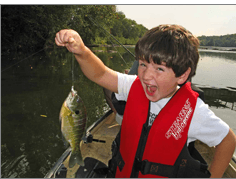Fish are a popular item for lake and pond clients as fishing allows for continuous fun for children and adults alike. Whether the waterbody is designed or capable of catch-and-release fishing or for eating fish, fish stockings may be necessary to ensure those goals can be met. While completing orders for numerous lake and pond clients over the years there are similarities with the types of questions WLPR sees.
Recommended Stocking Rates
Aside from those FAQ’s, we also place numerous fish orders based on pre-recommended hatchery rates (see table below). There are many scenarios outside of these guideline so feel free to contact us to discuss. Most ponds in Wisconsin are considered warm water ponds which are best stocked with bass and bluegills. Not to say that those are the only species you can stock, these are just the species that will thrive in most situations.
The stocking recommendations below are rough estimates for ponds 1 acre, with an 8 foot average depth and adequate oxygen.
| Species List | Initial Stocking Rate | Supplemental Stocking Rate |
| Fathead Minnows | 25-50 pounds | 50-100 pounds |
| Bluegill | 300 | 100-200 |
| Pumpkinseed | 300 | 100-200 |
| Hybrid Bluegills | 500 | 200-300 |
| Largemouth Bass | 100 | 25-50 |
| Smallmouth Bass | 100 | 25-50 |
| Yellow Perch | 200 | 100 |
| Walleye | 20 | 10-15 |
| Northern Pike | 2-4 | 1-2 |
| Muskellunge or Tiger Musky | 1-2 | 1-2 |
| Rainbow Trout (fall only) | 50 pounds | 20-30 pounds |
Spawning Information
Many people often wonder when fish spawn and how often. Typically most fish spawn in the spring of the year when temperatures are between 40 and 65 degrees. Bluegills will spawn later in the spring when water temperatures are between 65 and 80 degrees. Bluegills have been known to spawn more than one time in a season, but this is not typical. Largemouth and smallmouth bass will spawn when water temperatures are between 58 and 65 degrees. Once they reach maturity they will spawn every spring. Walleye typically spawn in the spring and look for water temperatures to be 48 to 55 degrees. Northern pike are typically the first game fish to spawn in the spring, needing temperatures of 40-48 degrees for spawning. They have been known to spawn under the ice in certain situations. Musky are another fish to spawn in early spring typically with water temperatures ranging from 48-55 degrees.
Water Chemistry
Water chemistry is very important to a healthy fish population. Most ponds and lakes in Wisconsin can have a healthy fish population without many problems. There are not many situations where water chemistry will not allow for the stocking and survival of fish. The major water chemistry factors involved in fish survival are temperature, dissolved oxygen, pH, ammonia and nitrites. Each one of these presents its own danger when it comes to the health of your fish. All of these factors should be looked at prior to stocking any fish.
Temperature ranges for most fish are generally not a problem. Most fish that are stocked in ponds can tolerate most water temperatures we will experience in Wisconsin. During the summer months certain species may not survive as well due to high temperatures. These species would be walleye, perch, and trout. Once water temperatures reach 70 degrees these species will have a hard time surviving. Walleye and perch can survive in most ponds that have depths over 8 feet since the water temperatures at the bottom of a lake or pond will stay below 70 degrees in most cases.
Dissolved oxygen is one of, if not the most, important water quality parameter that needs to be looked at prior to stocking fish. Not only does it provide oxygen for the fish, but it also provides oxygen to many microbes and insects that help aid in the overall heath of lakes and ponds. Dissolved oxygen levels need to be at 3 parts per million (ppm) throughout the water column in order to sustain a healthy fishery. If your lake or pond struggles with dissolved oxygen levels, we can assist you with the installation of an aeration system for fish management in your pond.
Alkalinity is the measure of the waters capacity to neutralize acids. Alkalinity levels between 50 and 250 mg/L are considered acceptable levels. Most times this parameter is not an issue.
The pH of water is generally not an issue in most lakes and ponds. Typically pH levels in most Wisconsin waters range from 6-8, which is recommended for most freshwater fish species.
Ammonia levels can and will pose major threats to a fish population. Ammonia generally becomes a problem in smaller ponds that have problems with dissolved oxygen. With proper oxygen levels ammonia is less likely to become a problem.
Nitrites can cause major fish kills in ponds and are closely related to ammonia. As fish release waste into the water, bacteria (nitrosomonas) break down the ammonia into nitrites. These nitrites are then consumed by another group of bacteria (nitrobacter), which will convert nitrites into nitrates. Nitrates are then utilized by plant life within the pond.
Order your fish today!
Stock your pond with the exact type and amount of fish you want






